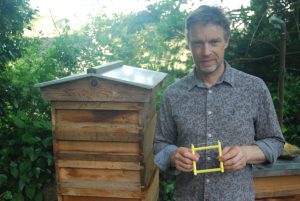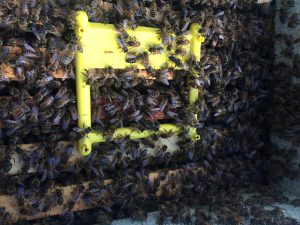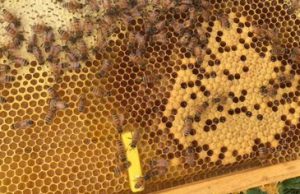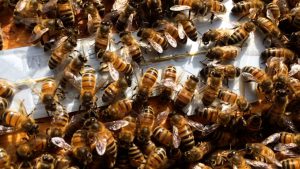
Inventor Stuart Roweth holds his creation, the Bee Gym.
Stuart Roweth
By: Tina Sebestyen
I first became acquainted with Stuart Roweth, who lives in England, after reading about his invention, the Bee Gym, on someone’s blog page several years ago. I ordered several of them, and Stuart and I began corresponding via email. Stuart’s interest in beekeeping began in 2011 with his propensity for inventing things. He has two other inventions: one is a double pot system allowing trees to survive on terraces and balconies, and the other is a multiplication engine for young students. Then he met a young man who started telling him about his adventures in beekeeping, and of course mentioned our arch-nemesis, Varroa destructor. Stuart started his beekeeping career the right way, with a mentor, and in joining a bee club. He did a little research, and after seeing the size of the mites in relation to their hosts, he thought it might be possible to build something that would help the bees rid themselves of mites. He came up with an idea, and made his first Bee Gym out of wood. It was a little contraption that looked like a tiny cattle guard with an entrance reducer that forced bees through a small gap, and had strings that would catapult the mites off the bees’ backs. Initial success was encouraging, 119 mites in one day. He made videos of the bees, and saw that they were choosing to go in the restricted area of the Bee Gym, and that they were grooming themselves there. When he learned a little more and knew that mites are underneath bees more than they are on their backs, he knew he needed to do something more.

The first Bee Gym that is meant to go in the
entrance so that the bees must walk through it.
Now, he needed to find a way to knock the mites off of the bees’ undersides. One idea was to use little brushes, but using an old mascara brush of his wife’s, he found that the mites had too good a hold and were too low to the bee to be removed with a brush. Fingernails were perfect, and he got the idea of little plastic flippers that bees could use to scrape mites off, whether purposely or accidentally when walking over the device in the hive. His wife worked in film and television, and in her workshop, they molded a little prototype that would hold both strings and flippers, out of two-part plastic. They made about forty of them, and gave them out to beekeepers. This was then superseded by a 3D printed design which was used to make an injection molding tool. They made about 5,000 of the square Bee Gyms, devices that go in the entrance and have both strings and flippers.
At this point, Stuart needed investors and beekeepers for testing, and found both. Vita Bee Health and the Devon Apicultural Research Group (DARG) did some testing, as did several individual beekeepers, like myself. Stuart decided to try placing grooming devices on brood combs, and invented the Mini Gym, a small bar that connects through the comb to a matching bar, both with mite flippers. He sent me several and I placed them in my hives, saving one pair for my observation hive. I saw the same thing that Stuart was learning through watching hundreds of hours of video of the bees with Gyms. The bees spend a lot of time on them. At first, it looked to me like the bees were trying to remove the flippers, and after about a week, they gave up on that and just spent time rubbing on them. Sometimes it looks like the bees are walking over them incidentally, as part of the hive architecture, which would still mean some efficacy. Once the bees get used to having the Mini-Gym in the hive, it really looks like they are purposely rubbing and grooming themselves on it.

The mini-Gym, that can be placed anywhere on wax foundation or foundationless comb. A good addition to an observation hive, especially since these are notoriously difficult to treat for mites.
This wasn’t enough for Stuart, who had more ideas brewing after a video conference with some of his testers, who thought that placement of the devices was critical. He created the Slim Gym, a grooming device to be placed on the top bars between boxes of the brood chamber. Again, he sent me several to try. I placed them on my hive bodies, with some concern about how hard it would be to clean the inevitable bur comb off of them, and how often that would be. I was pleasantly surprised to find that though some colonies do put wax on them, it isn’t much, and is easy to scrape off, once a season, after soaking in borax. I was even more pleasantly surprised to find that mite numbers stayed low all season (though as we beekeepers know, it might be the Gyms, and it might be one of a thousand other variables). This Spring, Stuart’s idea was to hang the Slim Gyms vertically between bars or frames, so that they would be right in the brood area, where mites like to hang out waiting to infest growing bee larvae and where we normally place treatment strips.
I counted for mites in all of my colonies, then started stapling the Slim Gyms to the top bars of frames, and found that this method works great for top bar hives, too. I decided that I wanted to also try drilling holes in them, and hanging them from a toothpick, so that the grooming device would be more equally spaced between the frames. After two weeks, I counted mites again, and counts in all colonies had dropped. Now, at the end of Summer, as always, some colonies have maintained low mite numbers, while some have risen. Only one colony with Slim Gyms has high numbers, and they are so high, I would normally count that as having received a mite bomb. Stuart suggested that I move the Slims around in the brood chamber, as it might increase their use. I must admit that I have not gone totally treatment free as Stuart requested at the beginning of this testing, but have treated when necessary over the past few years, mostly only using OA vapor in mid-Winter for those few hives with more than two mites per 300 bees.

The Slim Gym. We originally placed three on tops of frames, now hung between brood frames, and used in conjunction with the square Bee Gym in the entrance.
Stuart is careful not to claim that this is “the” answer to mites, but says that he has created another tool for our Integrated Pest Management tool box. He wants to be responsible in his advice, and suggests that when mite numbers rise above certain thresholds, chemical treatment should be done. He also acknowledges that some beekeepers will flat-out refuse to use any kind of treatment, and this is a tool for them and others to experiment with. I asked him what other kinds of IPM his other testers were using, and it is all across the board, from drone brood culling to sugar dusting. He loves that this empowers us, allowing us to taking back control and do something positive for our bees. The aim of the project is year-round varroa control. It leads to a different kind of beekeeping regimen, and it is more enjoyable, because we have the means in our hands to solve some of the problems for our bees.
I asked Stuart how his own bees were doing. He says that treating for mites interferes with the testing of the Bee Gyms, so he is bravely going without treatments, but uses drone brood culling and the grooming devices, and has not started introducing mite resistant queens yet. He has one colony that is seven years old, and another that is six, without collapse. Most of his other colonies are two to three years old. Stuart claims they have all become sustainable over the last few years as the Bee Gyms have become more effective. He has observed that mite numbers seem to be controlled better the longer the colonies survive, which made me wonder whether the bees become more adept at using them over time, or whether he thought they might also serve as training devices for more frequent grooming. He seemed cautiously hopeful.
I asked Stuart about how difficult and expensive it was to get a patent, since that might be something that would discourage a would-be inventor. He says that patents are easier to get and less expensive (at the start) in the UK than they are here in the U.S. I asked about future iterations of the Bee Gym, and whether he might have considered getting a GoFundMe page. He has definite steps in mind for the future of the Bee Gym, but wants to get better testing and hard numbers before moving forward. I think Stuart can be a motivational model for all of us; to put our ideas to the test, and not to be afraid to try.








